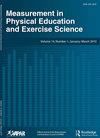用框架稳定测功机系统装置评估髋部力量的有效性和可靠性
IF 1.9
4区 教育学
Q2 EDUCATION & EDUCATIONAL RESEARCH
Measurement in Physical Education and Exercise Science
Pub Date : 2023-02-02
DOI:10.1080/1091367X.2023.2171796
引用次数: 0
摘要
目的是评估使用框架稳定测功仪(FSD)进行髋关节等距强度评估的内部和内部可靠性,并比较使用手持测功仪(HHD)进行髋关节内收(ADD)和外展(ABD)强度评估的结果。20名参与者(24.2[2.6]岁,69.3[10.0]公斤)接受了FSD (ADD和ABD短水平和长水平,内部[IR]和外部旋转[ER]测试)和HHD (ADD和ABD长水平测试)的测试。分析显示优良(ICC2)。k > 0.90),两次访问的组内和组间相对信度和测试-重测结果的良好信度(ICC2.1 0.79-0.90),无论测试如何。在这些测试中,SEM和MDC的IR和ER结果最高。与HHD相比,FSD测量的长杆ADD强度更高,长杆ABD强度更低。尽管这两种测量方法都被证明是高度可靠的,但两者之间存在差异。本文章由计算机程序翻译,如有差异,请以英文原文为准。
Validity and Reliability of Hip Strength Assessment Using a Frame-Stabilized Dynamometer System Device
ABSTRACT The purpose was to evaluate the intra- and inter-session reliability of hip isometric strength assessment using a frame-stabilized dynamometer (FSD) and to compare the results in the hip adduction (ADD) and abduction (ABD) strength assessment using handheld dynamometer (HHD). Twenty participants (24.2 [2.6] years, 69.3 [10.0] kg) underwent testing on an FSD (ADD and ABD short and long-lever, internal [IR] and external rotation [ER] tests) and using an HHD (ADD and ABD long-lever tests). Analysis revealed excellent (ICC2.k > 0.90) relative intra-set and inter-set reliability for two visits and good reliability for test-retest results (ICC2.1 0.79–0.90), regardless of the test. Among the tests, SEM and MDC were the highest for the IR and ER results. In comparison with HHD, long-lever ADD strength was higher and long-lever ABD strength was lower when measured using FSD. Although both measurements have been shown to be highly reliable, the discrepancy between the devices exists.
求助全文
通过发布文献求助,成功后即可免费获取论文全文。
去求助
来源期刊

Measurement in Physical Education and Exercise Science
Medicine-Orthopedics and Sports Medicine
CiteScore
4.20
自引率
33.30%
发文量
24
期刊介绍:
The scope of Measurement in Physical Education and Exercise Science (MPEES) covers original measurement research, special issues, and tutorials within six substantive disciplines of physical education and exercise science. Six of the seven sections of MPEES define the substantive disciplines within the purview of the original research to be published in the journal: Exercise Science, Physical Activity, Physical Education Pedagogy, Psychology, Research Methodology and Statistics, and Sport Management and Administration. The seventh section of MPEES, Tutorial and Teacher’s Toolbox, serves to provide an outlet for review and/or didactic manuscripts to be published in the journal. Special issues provide an avenue for a coherent set of manuscripts (e.g., four to five) to collectively focus in-depth on an important and timely measurement-related issue within the scope of MPEES. The primary aim of MPEES is to publish high-impact manuscripts, most of which will focus on original research, that fit within the scope of the journal.
 求助内容:
求助内容: 应助结果提醒方式:
应助结果提醒方式:


